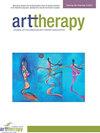A Review of ‘Quick and Creative Art Projects for Creative Therapists with (Very) Limited Budgets’
IF 1.3
Q3 PSYCHOLOGY, CLINICAL
引用次数: 0
Abstract
economic barriers. Additionally, she explores the power inherent in the ability of the individual to reflect the most intimate aspects of their story in their own way. Too often SUD clients are framed as “difficult clients”—a problem to be solved. In truth, they are people with a deadly and progressive disease whose reactive behaviors frequently reflect the levels of frustration, fear, and somatic symptoms they are experiencing. Schmanke endeavors to meet her clients at their place of need. She demonstrates this through multiple case studies and personal reflections that detail experiences with both individuals and groups. But she also addresses the practical aspects of integrating existing interventions into one’s practice, including demystifying 12-Step recovery and explaining the strong procedural CBT aspects of SUDfocused art therapy. Schmanke also provides concepts of her own interventions that explore countertransference and address cultural disparities as a means of aligning with the client in a common goal. Readers will come away with an understanding of the neuroscience of addiction (and the art therapy disciplines that invoke it), medication-assisted support in treatment, a surprisingly modern survey of drugs of abuse and dependence, and a generous aggregation of assessments, experientials and professional wisdom gathered from Schmanke’s studied knowledge of her subject, Art Therapy and Substance Abuse covers considerable ground but, more importantly, it is a very cogent summation of the modality’s power to honor the human being instead of just hammering home the need for change. Though many art therapists can find themselves at odds with institutional practices and procedures, Schmanke explores these environments with the reader and quietly reveals how mining existing models and interventions, which can correlate easily to art therapy practices and principles, can be a fruitful path to integration. In this way she is able to exact outcomes that are viable for the facility, meaningful for the client, and empowering for the practitioner. Schmanke recognizes and maximizes assets, a valuable skill in the treatment of SUD and perhaps even more valuable when navigating the commerce of behavioral health. As with anything that aspires to the breadth and depth of Art Therapy and Substance Abuse, some readers may be inclined contest aspects of its content or a few of the statistics represented here. It is this writer’s opinion that any fault one may find with Schmanke’s book is greatly overshadowed by its achievement. It’s unlikely that practitioners will find a more illuminating, thorough or useful text on the subject of art therapy and substance abuse. I am hopeful that this will be the first of many editions to come.“预算(非常)有限的创意治疗师的快速创意艺术项目”综述
经济壁垒。此外,她还探索了个人以自己的方式反映故事中最亲密方面的能力所固有的力量。SUD客户端经常被定义为“困难客户端”——这是一个需要解决的问题。事实上,他们是患有致命和渐进性疾病的人,他们的反应行为经常反映出他们所经历的沮丧、恐惧和身体症状的程度。Schmanke努力在客户需要的地方与他们见面。她通过多个案例研究和个人反思来证明这一点,这些案例研究和反思详细描述了个人和团体的经历。但她也谈到了将现有干预措施融入实践的实际方面,包括揭开12步康复的神秘面纱,并解释以SUD为重点的艺术治疗的强大程序CBT方面。Schmanke还提供了她自己的干预概念,探索反移情和解决文化差异,以此作为与客户达成共同目标的一种手段。读者将了解成瘾的神经科学(以及援引成瘾的艺术治疗学科)、药物辅助治疗支持、令人惊讶的滥用和依赖药物的现代调查,以及从Schmanke对其学科的研究知识中收集的评估、经验和专业智慧的大量集合,《艺术治疗和药物滥用》涵盖了相当多的领域,但更重要的是,它非常有说服力地总结了这种模式的力量,以尊重人类,而不仅仅是强调改变的必要性。尽管许多艺术治疗师可能会发现自己与机构实践和程序不一致,但Schmanke与读者一起探索了这些环境,并悄悄地揭示了挖掘现有的模式和干预措施是如何成为一条富有成效的整合之路的,这些模式和干预可以很容易地与艺术治疗实践和原则相关联。通过这种方式,她能够得出对机构可行、对客户有意义、对从业者有帮助的结果。Schmanke认识到并最大限度地利用资产,这是治疗SUD的一项宝贵技能,在行为健康商业中可能更具价值。与任何渴望艺术治疗和药物滥用的广度和深度的东西一样,一些读者可能倾向于对其内容的各个方面或这里所代表的一些统计数据提出质疑。这位作家认为,人们在施曼克的书中发现的任何错误都会被它的成就所掩盖。从业者不太可能找到关于艺术治疗和药物滥用主题的更具启发性、更彻底或更有用的文本。我希望这将是许多版本中的第一个。
本文章由计算机程序翻译,如有差异,请以英文原文为准。
求助全文
约1分钟内获得全文
求助全文
文献相关原料
| 公司名称 | 产品信息 | 采购帮参考价格 |
|---|

 求助内容:
求助内容: 应助结果提醒方式:
应助结果提醒方式:


